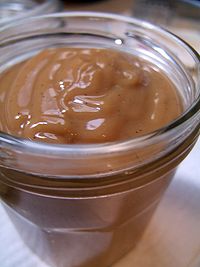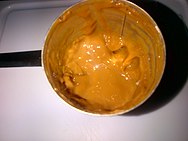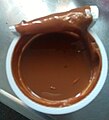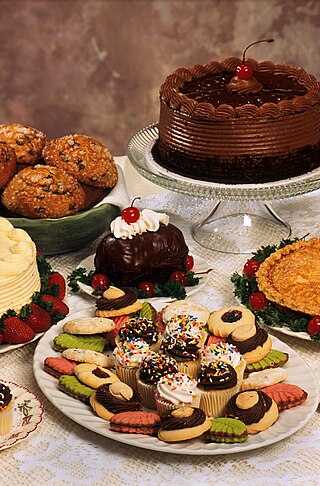
Dessert is a course that concludes a meal. The course consists of sweet foods, such as cake, biscuit, ice cream and possibly a beverage such as dessert wine and liqueur. Some cultures sweeten foods that are more commonly savory to create desserts. In some parts of the world there is no tradition of a dessert course to conclude a meal.
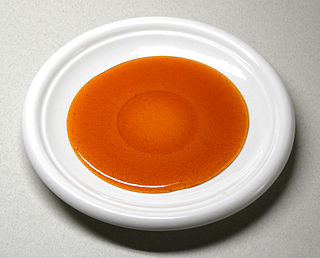
Caramel is a confectionery product made by heating a range of sugars. It is used as a flavoring in puddings and desserts, as a filling in bonbons or candy bars, or as a topping for ice cream and custard.

Brazilian cuisine is the set of cooking practices and traditions of Brazil, and is characterized by European, Amerindian, African, and Asian influences. It varies greatly by region, reflecting the country's mix of native and immigrant populations, and its continental size as well. This has created a national cuisine marked by the preservation of regional differences.
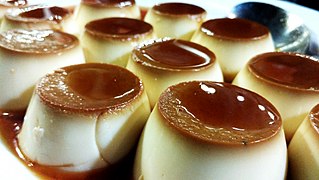
Crème caramel, flan, caramel pudding, condensed milk pudding or caramel custard is a custard dessert with a layer of clear caramel sauce.

Condensed milk is cow's milk from which water has been removed. It is most often found with sugar added, in the form of sweetened condensed milk, to the extent that the terms "condensed milk" and "sweetened condensed milk" are often used interchangeably today. Sweetened condensed milk is a very thick, sweet product, which when canned can last for years without refrigeration if not opened. The product is used in numerous dessert dishes in many countries.

A wafer is a crisp, often sweet, very thin, flat, light biscuit, often used to decorate ice cream, and also used as a garnish on some sweet dishes. They frequently have a waffle surface pattern but may also be patterned with insignia of the food's manufacturer or may be patternless. Some chocolate bars, such as Kit Kat and Coffee Crisp, are wafers with chocolate in and around them.

Caramelization is a process of browning of sugar used extensively in cooking for the resulting butter-like flavor and brown color. The brown colors are produced by three groups of polymers: caramelans (C24H36O18), caramelens (C36H50O25), and caramelins (C125H188O80). As the process occurs, volatile chemicals such as diacetyl (known for its intense butter-like taste) are released, producing the characteristic caramel flavor.

Rice pudding is a dish made from rice mixed with water or milk and commonly other ingredients such as sweeteners, spices, flavourings and sometimes eggs.
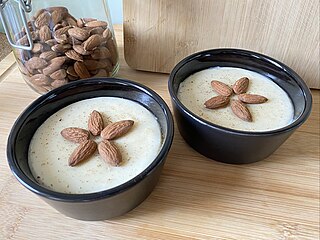
The manjar blanco, known in Catalan as menjar blanc or menjablanc, is a term used in Spanish- and Catalan- speaking areas of the world in reference to a variety of milk-based delicacies. It refers to variations of blancmange, a European delicacy found in various parts of the continent as well as the United Kingdom.
Quesillo refers to different Latin American, Spanish, and Filipino foods or dishes depending on the country:
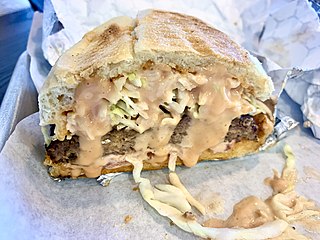
Dominican cuisine is made up of Spanish, Indigenous Taíno, Middle Eastern, and African influences. The most recent influences in Dominican cuisine are from the British West Indies and China.

Natillas is a term in Spanish for a variety of custards and similar sweet desserts in the Spanish-speaking world. In Spain, this term refers to a custard dish made with milk and eggs, similar to other European creams as crème anglaise. In Colombia, the delicacy does not include eggs, and is called natilla.
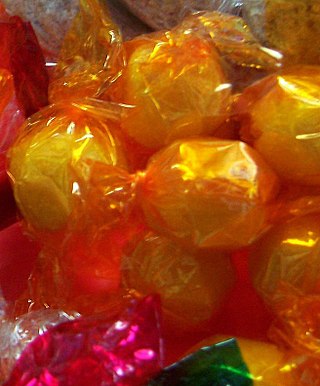
Yema is a sweet custard confectionery from the Philippines. It is made with egg yolks, milk, and sugar.

Flan cake, also known as leche flan cake or crème caramel cake, is a Filipino chiffon or sponge cake (mamón) baked with a layer of leche flan on top and drizzled with caramel syrup. It is sometimes known as "custard cake", which confuses it with yema cake. Modern versions of flan cake can be cooked with a variety of added ingredients. An example is the use of ube cake as the base.
